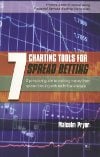

7 Charting Tools for Spread Betting

Malcolm Pryor
Reviewed by Michael Odell
- Avoid
- Browse
- Buy
- Love
- Never Play Without It
Renowned technical analyst and expert spread bettor Malcolm Pryor returns with valuable lessons that anyone can profit from. As the title suggests, Pryor presents readers with seven time-tested tools that can improve anyone's spread betting overnight. The author does a solid job of illustrating these winning strategies in his sensible yet impactful style. This informative book is simple enough for beginners yet sufficiently insightful that it's a worthwhile read for just about anyone looking to improve their spread bets.
Malcolm Pryor’s latest book, 7 Charting Tools for Spread Betting, is, as it sounds, a succinct guide to the best spread betting techniques. When compared with Pryor’s earlier title, Winning Spread Betting Strategies, 7 Charting Tools for Spread Betting is less focused on analytics. Instead, Pryor offers advice on how to use and engage some of the key tools in any trader's “arsenal”, as well as a range of case studies using examples from the FTSE 100.
Technical analysis is ideally suited for spread betting, where one can bet on short-term
price movements with leverages, and where part of the game is identifying logical places to
enter and exit a bet.
As Pryor suggests in the preface of the title, the focus in his new publication “is on practical use rather than academic theory” and offers a basic but comprehensive approach to spread betting. Indeed, 7 Charting Tools for Spread Betting shouldn’t be considered a direct follow-on from Winning Spread Betting Strategies; Pryor’s new title is aimed at “people with any level of technical analysis skills, from virtual beginners to advanced users”. In the case of the latter, it should be noted that it’s unlikely that advanced traders won’t have heard of some, if not all, of the tools Pryor outlines in his book. As the author suggests through the title, the tools come from various resources, including Welles Wilder’s now legendary spread betting tome, New Concepts in Technical Trading Systems. Others, such as tool number four, Support and Resistance, are a “hundred years” old. The book dedicates time to the following tools: ATR, Directional Movement, Moving Averages, Support and Resistance, Oscillators, Relative Strength, and Momentum.
However, while Pryor’s tools and techniques aren’t ground-breaking, his approach will no doubt prove refreshing to first time spread bettors. In each chapter, the author outlines the strengths, weaknesses and alternatives to the tools suggested. 7 Charting Tools for Spread Betting offers more than just an outline of some of the key techniques expert traders’ use, as Pryor takes the time to dissect, analyse, and evaluate each method. Perhaps the strongest part of the book is towards the end, where Pryor provides in-depth case studies using the tools described through the title, using real examples from the FTSE 100.
While Pryor provides a list of resources in 7 Charting Tools for Spread Betting, few online, or indeed offline based resources offer the same depth and clarity that Pryor illustrates through this title. Presented in bullet points and short sentences, 7 Charting Tools for Spread Betting accurately and clearly outlines essential trading advice, which shouldn’t be missed. Perhaps the only drawback of the title is the availability of the information included, as, after all, information about Pryor’s 7 spread betting tools can be found elsewhere. For readers who are looking for a more in-depth approach to spread betting, we recommend Pryor’s earlier title, Winning Spread Betting Strategies. 7 Charting Tools for Spread Betting is however, a useful guide for those who are new to spread betting.
